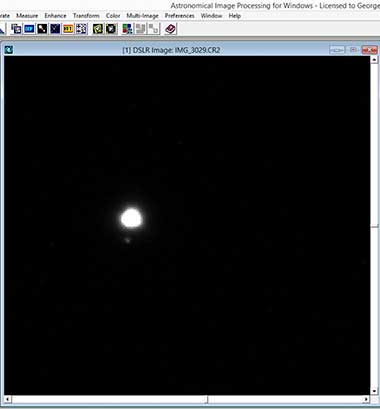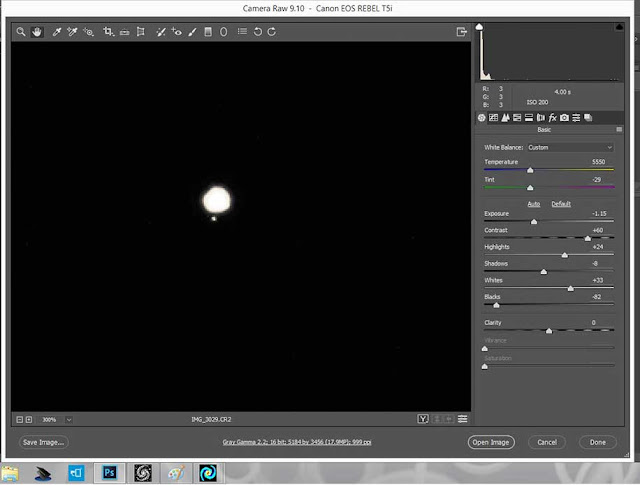Well this has been a busy week with a couple of interesting physics colloquia and three other astronomy related meetings and lectures. We are looking forward also to the OCA Astrophysics Sig and hopefully good observing at Blackstar. It has also been a week where I finally had an epiphany regarding why my Photoshop processed images were not as clear as the original images on the DSLR. It is sad to recognize that I have been doing the DSLR file format conversion for over two years now with old conversion software and have been leaving about 80% of the pixels behind. But before getting into those details we should
take a look at the incoming mail and pass on three short videos forwarded by our blog readers.
First up is an interesting short video showing what to me is the ideal electric vehicle. Resident Astronomer Peggy found this little video on Facebook. Yes, we are becoming surrounded by electric autos, but this new drone flying machine built for two looks really exciting and I want one. Check it out at:
https://www.facebook.com/futurism/videos/745693682276500/
Thanks for that Peggy!
Next up is this latest project proposal from NASA sent in by "In a superposition between Las Vegas and Riverside County, Ken." This NASA news announcement is for a fusion powered rocket ship that takes months off the flight time to Mars and beyond. Now, let me see, fusion power has been studied for over 50 years now and can't yet be made to work on Earth, so how is it going to work in constraints of outerspace? Anyway, check it out. Thanks Ken!
https://www.nasa.gov/directorates/spacetech/niac/2017_Phase_I_Phase_II/Gradient_Field_Imploding_Liner_Fusion_Propulsion_System
Finally, if you have always wanted to get a better understanding of dark energy, but didn't want to go through all the equations of cosmological general relativity, then check out this short video sent in by Wants to Build a Cubesat, Dr. Don. The video is a good description and has just a few equations to support the discussion. Thanks for that, Don!
https://www.youtube.com/watch?feature=youtu.be&v=UwYSWAlAewc&app=desktop
This week's OCA general meeting had a great presentation by Dr Laura Sales, UCR on the formation of galaxies. She was very entertaining and informative and fielded some tough questions and described some of the ongoing research activities and spelled out a couple of outstanding problems in the formation of galaxies that still puzzle the astrophysicists. One of which is called the "missing satellites problem," which is concerned with the prediction of hundreds of times more satellite galaxies to be found orbiting the typical galaxy, when in reality for our own Milky Way, only a couple of dozen satellite galaxies, like the LMC and SMC, for example, are observed. Why this discrepancy? She said there is some conflict between the dark matter simulations, which predict large numbers of satellites, and the astronomical observations which, although more very dim satellite galaxies keep being found, and the actually observed number of satellites. Thank you Professor Sales.
It turns out that just by chance, Dr Andrew Wetzel, Caltech, presented his team's latest research on galaxy formation at the Carnegie Observatory's lecture series held at the Huntington Library. Luckily, these public lectures are webcast live and you don't have to drive into Arcadia or Pasadena to hear and see the presentation. His presentation tackled this missing satellite problem head on. It seems that the missing satellite problem started off by galaxy formation simulations that only included dark matter and these simulations predicted hundreds of times of many satellite galaxies. But, when more physics, such as feedback from ordinary matter and effects of star formation and supernova explosions, which disperse matter and limit how fast ordinary matter can collapse to form stars and galaxies, it turns out that the predicted number of satellite galaxies around the typical Milky Way sized galaxy, is predicted to be only a couple of dozen satellites. Hey, how about that! Now the predictions match the observations and the Milky Way need not be a special galaxy at all. This is not a case of just fitting the model predicted data to fit the observed data points, but the incorporation of additional known physics which then gives the right answer. He said it is only now that large supercomputers are available that can include more and more of these stellar physics feedback conditions that the simulations better and better match the observation of galaxy formation. Pretty neat, thank you Professor Wetzel and the Carnegie Observatories. By the way, this lecture and others is cataloged and viewable on the Carnegie website.
Ok, now finally we can leave theoretical physics aside and return to the observational challenges facing all of us amateur observational astronomers. This learning curve topic is best summarized by what I call a Photoshop "epiphany". Now I have been using Photoshop for several years now to do additional photo processing on all of my astromimages and have never really understood or used more than just a small fraction of the tools available in Photoshop, but it came as a complete shock to me to realize that when I was converting my Canon DSLR CR2 images to Photoshop that I was leaving most of my image pixels out of the loop.
The first hint that something, other than just a dim recognition that my Photoshop processed images were not as clear and sharp as images seen on the Canon DSLR Liveview screen, was when I could clearly recognize the binary nature of the North Star, Polaris, in the AIP4WIN analysis of the star's image, but that my Photoshop processed image did not show any small companion star at all.
 |
| Using AIP4WIN clearly shows the binary nature of Polaris (Source: Palmia Observatory) |
When I started investigating what was going wrong, I found that the most likely cause was not having the latest conversion program that converts Canon CR2 photo images to the right kind of format that Photoshop can read. My DSLR images are composed of pixels arranged in a 5184 x 3456 sized pixel array and yet, the initial Photoshop conversion of the CR2 format resulted in a modified image of only 1000 x 667 pixels. Wow, I was losing over 80% of my pixels! That is not good. Why did it take me so long to recognize this? Ok, ok, I guess that is why I am an amateur; always getting a learning lesson.
So, I found and downloaded the latest Photoshop plugins and updates and saw an immediate improvement in the conversion process. The screen shot below now shows the binary companion and also shows the converted image is the full 5184 x 3456 pixels in size. Now, this resolution is as good as I had been getting with AIP4WIN software and much, much better than what I was getting with the out of date Photoshop plugins.
 |
| Using the latest CR2 conversion plug ins resulted in full 5184 x 3456 pixel image size (Source: Palmia Observatory) |
Ok, so far so good, but when I completed the conversion process and brought the converted image into Photoshop for further processing, I find that for some reason the image has lost a lot of resolution. Check out the screen shot below and you will notice that the binary companion star is just almost completely absorbed into the larger one> What happened?
 |
| What happened in Photoshop to cause this loss of pixels? |
So, using the latest plugins for Photoshop helped with the conversion process and seemed to pass on all the pixels that make up the DSLR image, but once the image is in Photoshop format some detail is still missing. I don't know what I'm doing wrong or what I forgot to set up in some obscure Photoshop menu. Maybe some more experienced Photoshop user can let me in on the secret.
Anyway, I imported the image of the full moon, that was posted in last week's blog, and do see some improvement in the sharpness and clarity, but still it does not seem as good as it looks just on my camera.
 |
| Image of full moon gets a little clearer with the lasted CR2 conversion plugins (Source: Palmia Observatory) |
Well, that s about enough for this week. I'm a little discouraged about finding out that I have been throwing away so many pixels, especially since it is so hard to get astronomical photons to land on those pixels in the first place. Well, we must go on. Maybe this weekend the weather will stay clear and we will be able to get in some darker sky observing at Blackstar Canyon. I hope so, because other than that date, we are busy packing up for our river cruise around Amsterdam and won't have many observing opportunities till we get back.
Until next time,
If you are interested in things astronomical or in astrophysics and cosmology
Check out this blog at www.palmiaobservatory.com

No comments:
Post a Comment